Click on images to enlarge

infestation (Photo: Sheldon Navie)
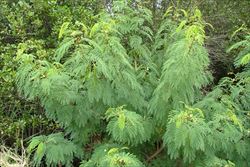
habit (Photo: Sheldon Navie)

habit in fruit (Photo: Sheldon Navie)

twice-compound leaves and flower clusters (Photo: Sheldon Navie)
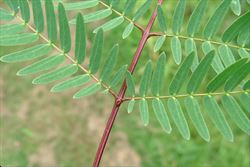
close-up of leaf showing raised gland and elongated leaflets (Photo: Sheldon Navie)

young flower clusters in bud (Photo: Sheldon Navie)
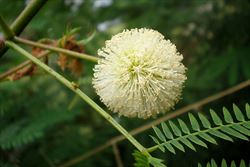
close-up of flower cluster and leaf stalk with raised gland (Photo: Sheldon Navie)

old flower cluster with young fruit beginning to develop (Photo: Sheldon Navie)
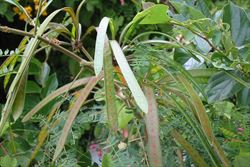
immature fruit (Photo: Sheldon Navie)

mature fruit (Photo: Sheldon Navie)
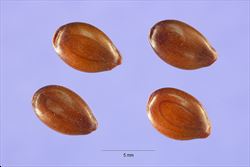
close-up of seeds (Photo: Steve Hurst at USDA PLANTS Database)
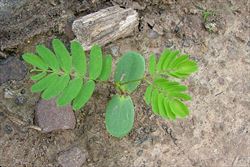
young seedling (Photo: Sheldon Navie)
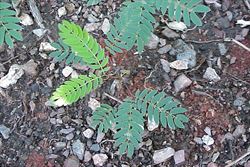
older seedling (Photo: Sheldon Navie)
Scientific Name
Leucaena leucocephala (Lam.) de Wit
Two sub-species are present in Australia:Leucaena leucocephala (Lam.) de Wit subsp. glabrata (Rose) ZárateLeucaena leucocephala (Lam.) de Wit subsp. leucocephala
Synonyms
Acacia leucocephala (Lam.) LinkLeucaena glauca (L.) Benth. (misapplied)Mimosa leucocephala Lam.
Family
Fabaceae: sub-family Mimosoideae (New South Wales)Leguminosae (South Australia)Mimosaceae (Queensland, the ACT, Victoria, Tasmania, Western Australia and the Northern Territory)
Common Names
coffee bush, cow tamarind, horse tamarind, jumbie bean, lead tree, leadtree, leucaena, white leadtree, wild tamarind
Origin
Native to southern Mexico and parts of Central America (i.e. Belize and Guatemala).
Cultivation
Leucaena (Leucaena leucocephala) is widely cultivated as a forage legume in the warmer parts of Australia. It has also been cultivated as a garden ornamental.
Naturalised Distribution
This species is widely naturalised and relatively common in the coastal and sub-coastal districts of northern and eastern Australia. It is most common in south-eastern, central and northern Queensland and in the northern parts of the Northern Territory. Also present in the coastal districts of northern and central New South Wales, in the coastal districts of Western Australia, on Christmas Island and on the Cocos Islands.
Habitat
A very troublesome weed of waterways and roadsides in tropical and sub-tropical regions. It is also found in open woodlands, gardens, parks, waste areas, disturbed sites and on coastal foreshores and offshore islands.
Habit
A shrub or small tree usually growing 2-10 m tall, but occasionally reaching up to 15 m or more in height.
Distinguishing Features
- a shrub or small tree growing up to 10 m or more tall.
- its twice-compound leaves have several branchlets, each with numerous pairs of small leaflets.
- its whitish, cream or pale yellow flowers are borne in dense rounded clusters (1-3 cm across).
- its elongated and flattened pods (8-18 cm long and 2 cm wide) turn brown or reddish-brown as they mature.
Stems and Leaves
The younger stems are green and usually densely covered in fine greyish coloured hairs (i.e. finely pubescent). Older stems have a relatively smooth, greyish or greyish-brown, bark with numerous small raised spots (i.e. lenticels).
The leaves (up to 35 cm long) are twice-compound (i.e. bipinnate) and have 3-10 pairs of branchlets (i.e. pinnae). They are alternately arranged along the stems and borne on stalks (i.e. petioles) 2-5 cm long. A small raised structure (i.e. gland) is usually present on the leaf stalk (i.e. petiole), or just below where the lowest pair of branchlets (i.e. pinnae) meet. The branchlets (i.e. pinnae) are 2-10 cm long and each bears 5-22 pairs of leaflets (i.e. pinnules). These leaflets (7-21 mm long and 1.5-5 mm wide) are elongated (i.e. narrowly-oblong to lanceolate) in shape with pointed tips (i.e. acute apices), and are either hairless (i.e. glabrous) or have hairy (i.e. ciliate) margins.
Flowers and Fruit
The flowers are borne in dense globular clusters (12-30 mm across), which look like a 'pompom' when the flowers open. These clusters are borne in the leaf forks (i.e. axils) on stalks (i.e. peduncles) 2-6 cm long, with one to three clusters present in each leaf fork (i.e. axil). Each of the small flowers has five tiny sepals (2-2.5 mm long), five small greenish-white coloured petals (2-4 mm long), and ten prominent pale yellow or whitish coloured stamens (6-10 mm long). Flowering occurs mostly during summer.
The fruit are elongated (i.e. linear), flatenned, pods with a pointed tip (i.e. beaked apex). These pods (8-22.5 cm long and 10-20 mm wide) are initially green in colour, but turn brown or reddish-brown as they mature. Several pods will usually develop from each flower cluster. Each of these pods contains 10-25 hard seeds (6-10 mm long and 3-6 mm wide) that are glossy brown, flatenned (i.e. compressed), and somewhat oval (i.e. elliptic-oblong) in shape.
Reproduction and Dispersal
This species is a prolific seed producer and it also resprouts after its stems are deliberately cut or otherwise damaged.
The seeds are often dispersed by small animals (i.e. rodents and birds) and cattle. The light pods may also be spread short distances by wind and can float on water.
Environmental Impact
Leucaena (Leucaena leucocephala) is regarded as an environmental weed in Queensland, the Northern Territory, Western Australia, New South Wales, and on Christmas Island. It is actively managed by community groups in Queensland and the Northern Territory and was recently listed as a priority environmental weed in three Natural Resource Management regions.
It is also very invasive in other parts of the world, being listed in the Global Invasive Species Database (GISD) and regarded to be in the top 100 of the world’s worst invasive alien species.
Legislation
Not declared or considered noxious by any state government authorities.
Management
For information on the management of this species see the following resources:
- the Biosecurity Queensland Fact Sheet and Pest Status Review on this species, which are both available online at http://www.dpi.qld.gov.au.
Similar Species
There are two sub-species present in Australia: Leucaena leucocephala subsp. leucocephala (which is very common and widespread) and Leucaena leucocephala subsp. glabrata (which is currently restricted to a few localities in central Queensland). These two sub-species can be distinguished by the following differences:
- Leucaena leucocephala subsp. leucocephala is a relatively small and much-branched tree with younger stems that are densely covered with fine greyish-coloured hairs (i.e. they are puberulous).
- Leucaena leucocephala subsp. glabrata is a relatively large and sparsely-branched tree with younger stems that are hairless (i.e. glabrous).
Redwood (Acaciella glauca) and Bolivian wattle (Acaciella angustissima) are quite similar to leucaena (Leucaena leucocephala). These species can be distinguished by the following differences:
- leucaena (Leucaena leucocephala) usually has smooth, finely hairy (i.e. puberulous), younger stems that are greenish in colour. Its leaflets are relatively large (7-21 mm long and 1.5-5 mm wide) with pointed tips (i.e. acute apices). Its pods are relatively large (8-22.5 cm long and 10-20 mm wide) and contain 10-25 seeds.
- white ball acacia (Acaciella glauca) has smooth, almost hairless (i.e. glabrescent), younger stems that are reddish in colour. Its leaflets are relatively small (4-8 mm long and about 2 mm wide) with rounded tips (i.e. obtuse apices). Its pods are relatively small (4-7 cm long and about 10 mm wide) and contain 5-8 seeds.
- Bolivian wattle (Acaciella angustissima) has slightly grooved (i.e. striated), finely hairy or hairless (i.e. puberulous or glabrous), younger stems that are greenish in colour. Its leaflets are very small (3-4 mm long and 0.5-1 mm wide) with slightly pointed tips (i.e. acute apices). Its pods are relatively small (4-8 cm long and 8-14 mm wide) and contain about 5-8 seeds.
Mackay cedar (Paraserianthes toona), forest siris (Albizia procera) and Indian siris (Albizia lebbeck) may occasionally also be confused with leucaena (Leucaena leucocephala), but these species all have much larger leaflets. Some of the white-flowered native wattles (Acacia spp.) are also similar.

